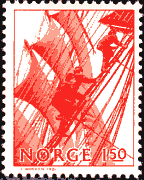
| Maritime Topics On Stamps:
The sister ships of the 'Gorch Fock':
|
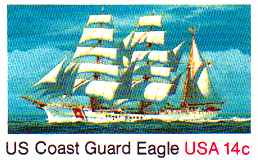
| |
'Eagle', 'Sagres(2)' and 'Mircea' !
|
Specifications of the 'Eagle' ex 'Horst Wessel':
- Built 1936 at Blohm & Voss shipyard, Hamburg.
- Three-masted bark, steel hull.
- Length x Beam x Draft = 295 x 39 x 17 feet.
- 1390 GRT, 1634 ts displacement.
- 22 sails, altogether 1983 square meters.
- Height of main mast over deck 149 feet.
- Auxiliary engine 750 HP, speed of 10 knots.
- Speed under sail max. 18 knots.
- 65 men regular crew, plus approx. 180 cadets.
|
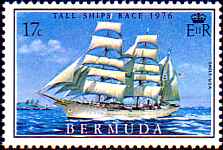
|

|

| |
Having commissioned the 'Gorch Fock' (1) in1933, the German Navy decided that
additional sail training vessels were needed for the young sailors of the
expanding Kriegsmarine. The second ship built to the plans of the 'Gorch Fock'
was launched in 1936 and named 'Horst Wessel' (after a Nazi ‘martyr’ of the
1920s). Until the outbreak of WW II she undertook many sail training cruises,
then was used to transport troops and supplies in the Baltic. Stationed at Kiel
at the end of the war.
|

|
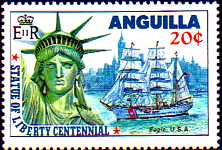
| |
After the war she was handed over to the U.S.
Coast Guard as reparation. In 1946 she was christened USCG cutter ‘Eagle’,
then sailed to the United States by her German crew under U.S. command and with
American trainees. The seventh ‘Eagle’ to serve under the U.S. flag (the first
one dates to 1792), she is attached to the U.S. Coast Guard Academy in New
London, Connecticut. Two lengthy annual cruises take her into U.S. ports and
Central American and European waters. Well known for her appearance in several
‘Operation Sail’ events, she has also participated - and continues to do so - in
many ‘Tall Ship Races’ over the past five decades, being known to have
attained speeds of 18 knots under full sails with favorable winds!
Under the German flag she was already adorned with a gigantic eagle
figurehead, albeit one holding in its claws a swastika surrounded by an oakleaf wreath.
With the swastika cut out, she sported this eagle for more than 20 years.
Today it may be seen at the U.S.C.G. museum in New London, CT. A succession of
smaller eagle figureheads followed, several having fallen victims of the wrath
of the seas...
|
|
This stamp shows the 'Sagres (1)' which served the Portuguese Navy as a sail
training vessel from 1924 to 1962. Her name honors the small port of Sagres in
the south of Portugal where Henry the Navigator’s first school of navigation
was based at the beginning of the 15th century.
This 3-masted bark started out as the German merchantman ‘Rickmer Rickmers’
in 1896, built at Bremerhaven. After 38 years in active Portuguese service, she
deteriorated as a depot ship renamed ‘Santo Andre’ until purchased by German
ship lovers in 1983. Lovingly restored, she can be visited today in Hamburg
harbor, Germany, as a museum ship/floating restaurant sporting again her old
name ‘Rickmer Rickmers’.
|
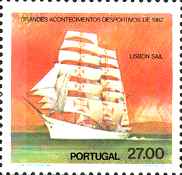
|

|
Specifications of the 'Sagres (2)’ ex 'Guanabara' ex 'Albert Leo Schlageter':
- Built 1937 at Blohm & Voss shipyard, Hamburg.
- Three-masted bark, steel hull.
- Length x Beam x Draft = 295 x 39 x 17 feet.
- 1550 GRT, 1869 ts displacement.
- 23 sails, altogether 1796 square meters.
- Height of mainmast over waterline 148 feet.
- Auxiliary engine 700 HP, speed of 10 knots.
- 158 men regular crew and approx. 90 cadets.
|
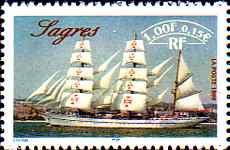
|
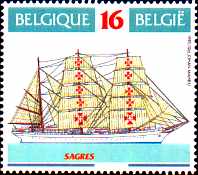
|
|
The 'Albert Leo Schlageter' was built in 1937 as the third sail training
vessel of the German Navy, again according to the plans of the first 'Gorch Fock'.
(And also named after another Nazi ‘martyr’, executed for terrorism in
1923). Until WW II several training voyages were accomplished, among others, also
to South America. During the war the ship was used as an administrative
office. In 1944 she met a mine off Sassnitz in the Baltic.
After the war she was seized by the United States. Since there was no need
for a second sailing ship, she was sold to Brazil in 1948. Renamed 'Guanabara',
the Brazilian Navy half-heartedly used her for a few years in sail training,
then allowed her to deteriorate badly.
[In 1961, this writer/translator observed both the ‘Guanabara’ and the
formerly beautiful ‘Almirante Saldanha’ -- with all masts cut down -- tied up in
Rio de Janeiro under the most deplorable conditions.]
Bought by the Portuguese Navy in 1962 to replace the 66-year old ‘Sagres
(1)’, she was brought back to life and seaworthiness. Conducting two annual
cruises from her home port Lisbon, ‘Sagres (2)’ is easily recognized by the red
Maltese crosses on her square sails.
Her figurehead represents a bust of Henry the Navigator.
|
|
This stamp depicts the Romanian brigg 'Mircea (1)', named for Duke Mircea of
the 14th century who fought the Turks, recovered ancient Romanian lands, and
invigorated maritime trades.
|
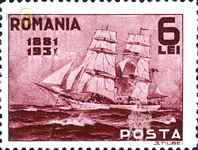
|
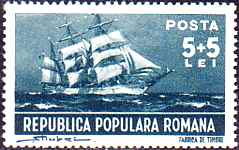
|
Specifications of 'Mircea (2)':
- Built 1938 at Blohm & Voss shipyard, Hamburg.
- Three-masted bark, steel hull.
- Length x Beam x Draft = 269 x 39 x 17 feet.
- 1312 GRT, 1760 ts displacement.
- 23 sails, altogether 1748 square meters.
- Height of main mast over keel of 161 feet.
- Auxiliary engine 1100 HP.
- 90 men regular crew, plus120 cadets.
|
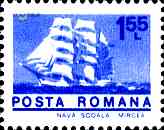
|
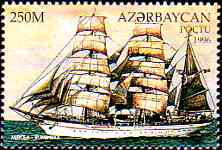
|
|
'Mircea (2)' was the third ship built according to the plans of the first
'Gorch Fock'. Commissioned in 1938, she has served the Romanian Navy ever since,
with time out sometime after WW II when she was briefly seized by the Soviets.
In 1966, during eight months at her original building yard of Blohm and Voss
in Hamburg, she was completely overhauled from top to bottom. Made her
post-war debut in the West during “Operation Sail 1986” in New York; still serving
her country’s navy until this day.
Her figurehead depicts a likeness of Romania’s legendary Duke Mircea.
|
>
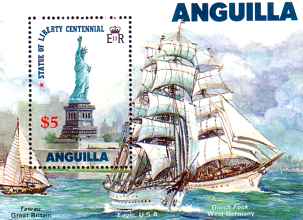
|
The first 'Gorch Fock' was built in 1933, followed by sister ships 'Horst
Wessel' (today’s 'Eagle') in1936, 'Albert Leo Schlageter' (today’s ‘Sagres’) in
1937, and the ‘Mircea’ in 1938.
In 1939 a fourth sister ship was launched, intended to be called ‘Herbert
Norkus’ (after a 15-year old Berlin Hitler youth killed by ‘reactionary’
adversaries). The ship was eventually completed up to the lower masts. All the
rigging was finished, too, but never got installed. During WW II the future
'Herbert Norkus' served as an accommodation ship in its yard.
After the war she was towed to Kiel, loaded with gas ammunitions, and sunk in
the Baltic Sea.
1958 saw the completion of the fifth sister ship of the first 'Gorch Fock',
the post-war West German Navy’s 'Gorch Fock(2)'. Parts of 'Herbert Norkus's
rigging were recycled in her construction.
On the souvenir sheet we see the 'Eagle' in the center, on the right of the
second 'Gorch Fock', and on the left of the small English 'Tawau'. Keen
observation of the depicted sailing positions shows that the wind is blowing from
different directions!
|
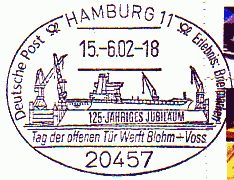
|
All the ‘Gorch Fock’ type ships presented here were built by the German
shipyard Blohm
& Voss in Hamburg. In the year 2002 the yard celebrated its 125th
anniversary (See cancellation at left). Over those years, this yard constructed giant
passenger liners and high-speed steamers, freighters of all types, battleships
and submarines, seaplanes, offshore oil drilling platforms, and the finest
sailing ships ever to fly across the Seven Seas.
Today the yard specializes in the construction of ferry boats, megayachts,
and frigates for the world’s navies.
|
|